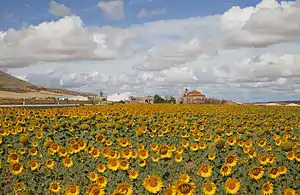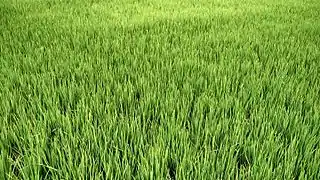Field (agriculture)
In agriculture, a field is an area of land, enclosed or otherwise, used for agricultural purposes such as cultivating crops or as a paddock or other enclosure for livestock. A field may also be an area left to lie fallow or as arable land.

Many farms have a field border, usually composed of a strip of shrubs and vegetation, used to provide food and cover necessary for the survival of wildlife. It has been found that these borders may lead to an increased variety of animals and plants in the area, but also in some cases a decreased yield of crops.[1]
Paddock
(NRCS_Photo_Gallery).tif.jpg.webp)

In Australian and New Zealand English, any agricultural field may be called a paddock, especially if for keeping sheep or cattle. If stock are grazed there, the space may be called a run, e.g. sheep run; cattle run.[2] The term paddock is used more specifically in animal husbandry for a system in which grazing land is divided into small areas, paddocks, and the stock graze each paddock in turn for a short period. Paddock grazing systems may be designed with, for example, 6 or 11 paddocks used in rotation.[3]
A paddock is normally fenced, usually by wire, and often defined by its natural boundaries, or is otherwise considered distinct. A back paddock is a smaller field that is situated away from the farm house; possibly land of lesser quality.[4] The equivalent concept in North America and the UK is a pasture.
In Australia the word seems to have had its current meaning since at least 1807[5] and in New Zealand since at least 1842.[6] However, the English meaning of "field" was used earlier in Australia[7] and is still occasionally used.[8] Similarly, meadow was in early use[9] and has appeared later, for example, in 2004.[10] Field remains in regular use in Australasia in expressions such as football field, Field Day and field trip.
In a new style of intensive farming developed in North America, a paddock is a small (perhaps 1 acre) temporary subdivision of a pasture made with electric fencing, which is intensely grazed for a day and then left to rest for perhaps 80 days or more.[11]
Image gallery
 A green field or paddock with Hereford cattle
A green field or paddock with Hereford cattle A summer field
A summer field Spring fields with trees, Majorca, Spain, 2004
Spring fields with trees, Majorca, Spain, 2004 Sown fields in an open field system of farming
Sown fields in an open field system of farming Wheat Field Under Clouded Sky by Vincent van Gogh, July 1890
Wheat Field Under Clouded Sky by Vincent van Gogh, July 1890
See also
| Wikimedia Commons has media related to Field. |
| Look up field in Wiktionary, the free dictionary. |
| Wikisource has the text of the 1911 Encyclopædia Britannica article Field. |
References
- Carpenter, Brent; Dailey, Thomas V.; Jones-Farrand, D. Todd; Pierce, Robert A.; White, Bill. "Field Borders for Agronomic, Economic and Wildlife Benefits". missouri.edu. Curators of the University of Missouri. Retrieved 1 November 2015.
- The Macquarie Dictionary run n. Def. 113
- Bertelsen, B. S.; Faulkner, D. B.; Buskirk, D. D.; Castree, J. W. (1993-06-01). "Beef cattle performance and forage characteristics of continuous, 6-paddock, and 11-paddock grazing systems". Journal of Animal Science. 71 (6): 1381–1389. doi:10.2527/1993.7161381x.
- definition of 'B-1', part of Australia Decoded at artistwd.com
- "Classified Advertising - The Sydney Gazette and New South Wales Advertiser (NSW : 1803 - 1842) - 12 Apr 1807". Trove. Retrieved 2017-04-13.
- "MR. SUTTON'S JOURNAL. (Continued from Number 4.) (New Zealand Colonist and Port Nicholson Advertiser, 1842-08-19)". paperspast.natlib.govt.nz National Library of New Zealand. Retrieved 2017-04-13.
- "HOT WINDS. - The Sydney Gazette and New South Wales Advertiser (NSW : 1803 - 1842) - 16 Oct 1803". Trove. Retrieved 2017-04-13.
- "A SUMMER SANS - Woroni (Canberra, ACT : 1950 - 2007) - 1 Feb 2007". Trove. Retrieved 2017-04-13.
- "NAMBOURG. - The Sydney Gazette and New South Wales Advertiser (NSW : 1803 - 1842) - 26 Mar 1803". Trove. Retrieved 2017-04-13.
- "TASMANIAN TRIBULATIONS - Woroni (Canberra, ACT : 1950 - 2007) - 16 Feb 2004". Trove. Retrieved 2017-04-13.
- Byck, Peter (27 November 2013). "SOIL CARBON COWBOYS" – via Vimeo.